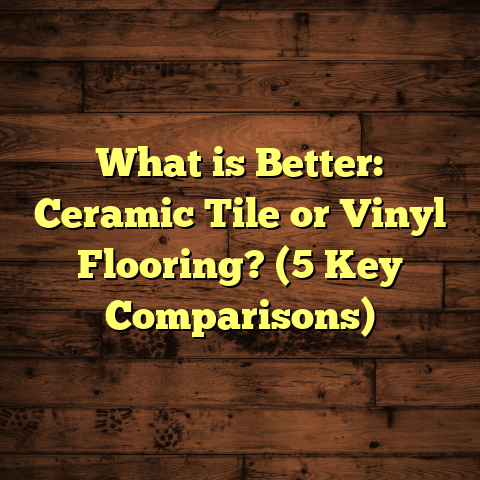What is Plank Wood Flooring? (5 Reasons to Choose It!)
Modern aesthetics have transformed the way we think about home interiors in so many ways. It’s no longer just about functionality or durability; it’s about creating spaces that feel warm, inviting, and full of character. Flooring plays a huge role in setting that tone. Over the years, I’ve worked with countless flooring types—from tiles to carpets—but plank wood flooring has always stood out as something special. It’s the kind of floor that doesn’t just sit beneath your feet but tells a story. If you’re curious about what plank wood flooring is all about and why it might be the perfect choice for your home, let me share what I’ve learned, experienced, and researched over the years.
What Is Plank Wood Flooring?
When I first started installing floors, I noticed people often confuse plank wood flooring with other hardwood floors. So let’s clear that up straight away.
Plank wood flooring consists of wide wooden boards—usually at least 3 inches wide—that are laid side by side to cover a floor. The “plank” term refers specifically to the width and length of the wood pieces used. Unlike traditional strip flooring, which uses narrower boards typically 1-2 inches wide, plank flooring’s wider boards showcase more of the wood’s natural grain and knots. This makes each plank a statement piece on its own.
There are two main types of plank wood flooring:
- Solid Plank Wood Flooring: These are cut from a single piece of hardwood. They offer authentic, natural wood throughout the thickness of the board.
- Engineered Plank Wood Flooring: These consist of a top layer of hardwood veneer bonded over multiple layers of plywood or other materials. This layered construction makes engineered planks more stable in environments with moisture or temperature changes.
I’ve worked with both types extensively, and each has its place depending on your home’s conditions and your personal preferences.
Why Wider Boards Matter
You might wonder why the width of the board makes such a difference. Well, wide planks allow the wood’s natural beauty to shine through. The grains, swirls, and imperfections become bold design elements rather than subtle background details.
When I installed plank flooring in my own living room, I was amazed at how those wider boards made the entire space feel more connected to nature. It’s like bringing a slice of the forest inside your home.
5 Reasons to Choose Plank Wood Flooring
Now, let me share five reasons why I often recommend plank wood flooring to homeowners looking for something reliable and beautiful.
1. Timeless Beauty That Adds Significant Value
Wood floors have been popular for centuries—and for good reason. According to data from the National Wood Flooring Association (NWFA), homes with hardwood floors can see an increase in resale value by up to 5%. Plank wood flooring, with its wide boards, offers an even more striking appeal because it highlights the natural features of the wood.
I had a client who was renovating an older home and was debating between tile and plank hardwood for the dining room. After we installed 4-inch wide oak planks with a hand-scraped finish, she told me she felt like she had added a piece of art to her home. The richness of the wood brought warmth that tiles simply couldn’t match.
This isn’t just about looks—it’s an investment that pays off if you ever decide to sell.
2. Durability That Can Last a Lifetime
Plank wood floors are built to last. Solid hardwood planks can be sanded and refinished multiple times—sometimes up to 10 or more—which can extend their lifespan well beyond 100 years if properly cared for.
In one job I took on, the homeowners had original plank floors from the 1930s that were scratched and dull but still structurally sound. After refinishing, those floors looked brand new but kept their vintage charm intact. You just can’t get that kind of longevity with laminate or vinyl options.
Engineered planks are also very durable, especially in areas prone to humidity fluctuations like basements or kitchens.
3. Simple Maintenance Keeps Them Looking Great
If you dread constant floor cleaning or worry about damaging your floors with kids or pets around, plank wood flooring is surprisingly low-maintenance.
Routine sweeping or vacuuming removes dirt particles that can scratch wood surfaces. A damp mop with a cleaner designed for hardwood keeps them shiny without damage.
If a single plank gets damaged—a deep scratch or dent—you don’t have to replace the whole floor. With solid planks, you can sand and refinish just the affected board; with engineered planks, it’s often possible to swap out individual pieces.
I worked with a young family who loved their wide plank floors despite having two energetic toddlers. They told me they worried about scratches but found that regular care and some occasional touch-ups kept everything looking great.
4. Design Flexibility for Every Style
One thing I love about plank wood flooring is how adaptable it is to different design styles. Wide planks come in various species, each with unique colors and grain patterns—oak, maple, hickory, walnut—you name it.
You can stain them dark for a rich, dramatic look or keep them light for an airy feel. Finishes range from matte to glossy depending on your taste.
For example, I installed wide white oak planks in a coastal cottage recently with a soft gray stain that perfectly complemented the light blues and whites throughout the interior. The floors added texture without overpowering the tranquil vibe.
On the flip side, dark walnut planks are fantastic for creating cozy, elegant spaces like libraries or formal dining rooms.
5. An Environmentally Responsible Choice
If you care about sustainability as much as I do, plank wood flooring can be an eco-friendly option—especially when sourced responsibly.
Solid hardwood comes from trees that are harvested sustainably when certified by organizations like the Forest Stewardship Council (FSC). Engineered wood uses less solid wood overall since it layers thinner veneers over plywood cores.
Many manufacturers now emphasize using reclaimed or responsibly harvested wood to reduce environmental impact.
I’ve had clients who were thrilled to find FSC-certified plank flooring options that aligned with their green building goals without compromising on style or quality.
Personal Stories: What Installing Plank Wood Floors Has Taught Me
I’ve installed countless plank wood floors over my career, and every project has taught me something new. One story stands out: A couple bought a fixer-upper that needed everything—from new wiring to flooring. They wanted something timeless but affordable.
We chose 5-inch distressed oak planks with a matte finish for their main living areas. The wide boards instantly made the space feel larger and more inviting. Months later, they told me how much they appreciated how easy it was to keep clean despite daily wear from their two dogs.
Another time, I helped a client choose between solid and engineered plank floors for their basement renovation. Because their home had radiant heating and occasional moisture issues downstairs, we went with engineered planks. The installation went smoothly, and they were amazed at how natural the floor looked compared to laminate alternatives.
These experiences show me that plank flooring isn’t just about aesthetics; it’s about matching needs and lifestyle too.
Diving Into Data: What Research Reveals About Plank Wood Flooring
I like backing up my recommendations with real data whenever possible:
- Market Trends: The global hardwood flooring market is projected to grow at around 6% annually through 2028. Plank-style products are driving much of this growth because they combine durability with style.
- Lifespan: Studies show solid hardwood floors can last over 100 years when properly maintained—far longer than laminate or vinyl alternatives which generally last 10-20 years.
- Cost: Installed costs for plank wood flooring typically range from $8 to $15 per square foot depending on species, finish, and labor rates.
- Environmental Impact: FSC-certified wood products represent over 80% of responsible hardwood sales worldwide as consumers demand greener options.
- Home Value: According to Remodeling Magazine’s Cost vs. Value Report, hardwood flooring projects recoup around 70-80% of their cost at resale—among the highest returns for home upgrades.
These numbers confirm what I see day-to-day: Plank wood flooring is a smart mix of beauty and value.
Case Study: Revamping a Living Room with Plank Wood Flooring
Let me share a detailed case study from a recent project that really highlights why plank wood flooring works so well.
A family approached me wanting to update their dark, dated living room into something bright but cozy. We chose 5-inch wide white oak planks finished with a natural oil stain that enhanced the grain while keeping a soft matte sheen.
After installation, the family loved how the floor changed throughout the day—from soft golden hues in morning sunlight to richer amber tones as evening fell. The wider boards made the room feel larger by reducing visible seams compared to narrower strips they had before.
Six months later, they reported minimal maintenance needs and said their kids’ playtime scratches barely showed thanks to the durable finish. The floor had become the centerpiece of their living space without sacrificing practicality.
This project reinforced my belief that plank wood flooring offers design versatility paired with real-life durability—a winning combination for family homes.
Common Questions About Plank Wood Flooring
I get asked plenty of questions when people consider plank wood flooring. Here are some answers based on my hands-on experience:
Q: Will wide plank floors scratch easily?
A: Like all hardwoods, they can scratch if not cared for properly—but wider planks sometimes show scratches less clearly since each board has more visual interest and natural variation. Using furniture pads and regular cleaning helps prevent damage.
Q: Can I install plank flooring over radiant heat?
A: Yes! Engineered plank floors are especially suited for radiant heat systems due to their dimensional stability compared to solid planks.
Q: Should I pick solid or engineered planks?
A: Solid is ideal if you want maximum refinishing options over decades but requires stable humidity control. Engineered is better for moisture-prone areas or DIY floating installations.
Q: Are plank floors noisy?
A: Proper underlayment greatly reduces noise issues. Wider boards often creak less if installed correctly because there are fewer seams prone to shifting.
Q: How do I choose between different wood species?
A: Think about color preference, hardness (measured by Janka rating), and grain style. Oak is popular for its balance of hardness and beautiful grain; maple is harder but more subtle; hickory offers dramatic grain but can be harder to stain evenly.
Installation Tips From My Experience
Installing plank wood flooring isn’t difficult but requires attention to detail:
- Acclimation: Let the wood acclimate in your home environment for at least 72 hours before installation to avoid gaps or warping later.
- Moisture Testing: Always test subfloor moisture levels—especially important for solid hardwood.
- Expansion Gaps: Leave proper expansion gaps around edges since wood expands and contracts with humidity.
- Nailing/Glueing: Follow manufacturer guidelines—solid planks are usually nailed; engineered can be glued or floated.
- Finish Choice: Matte finishes hide scratches better; gloss finishes look sleek but show wear more easily.
I always remind homeowners that investing in professional installation pays off in long-term satisfaction and fewer problems down the road.
Caring For Your Plank Wood Floors Over Time
Keeping your plank floors looking great isn’t complicated:
- Sweep or vacuum regularly to remove grit that can scratch.
- Clean spills immediately with a dry or slightly damp cloth.
- Use cleaners specifically made for hardwood—avoid harsh chemicals.
- Replace furniture pads periodically.
- Schedule refinishing every 7-10 years depending on wear.
I find most families happily stick to this simple routine once they see how beautiful their floors remain year after year.
How Plank Wood Flooring Fits Different Rooms
Wondering where plank wood fits best? Here’s what I recommend based on experience:
- Living Rooms & Bedrooms: Perfect choice for warmth and comfort.
- Dining Rooms: Durable enough for heavy foot traffic plus spills.
- Kitchens: Engineered planks work best because they resist moisture better.
- Basements: Engineered preferred due to humidity fluctuations.
- Hallways & Entryways: Choose harder species like hickory or oak due to heavy wear.
Each room’s use helps determine which type of plank floor suits best.
Final Thoughts From My Flooring Journey
After installing hundreds of floors in dozens of homes, plank wood flooring remains one of my favorite options—and not just because it looks good on paper. It combines beauty, durability, flexibility, and sustainability into one package that fits many lifestyles.
Wide boards bring personality into rooms in ways narrow strips can’t match. They celebrate imperfections in wood that make every floor unique—something I truly appreciate as both an installer and homeowner myself.
If you’re thinking about giving your home new life underfoot, consider how plank wood flooring could tell your story for years to come.
If you have any questions about choosing or installing plank wood flooring—or want me to help you explore options tailored just for your space—just ask! I’m here to make sure you find the perfect floor that feels like home from day one.





